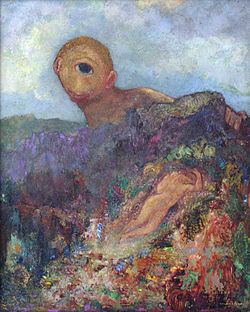Created 1914 | Period Symbolism Media Oil paint | |
 | ||
Similar Odilon Redon artwork, Symbolism artwork, Oil paintings | ||
The Cyclops is a painting by Odilon Redon depicting a myth starring an "unlucky naiad Galatea, loved by Polyphemus, the most famous Cyclops." Like most Cyclops in mythology, Polyphemus was villainized as a wild creature that hunted its victims and then consumed them. This subject had been painted before by artists such as Moreau; however Redon has taken this myth and given Polyphemus a makeover. In Redon's version, Polyphemus is shown as a non-threatening passive creature. The normally menacing beast is shown softly gazing with a large eye that has been seen in previous Redon works. Galatea, the naiad, is shown naked and vulnerably lying on a patch of vegetation. It appears Polyphemus is keeping one gentle eye watching over the "sexualized maiden." He has hidden himself from Galatea behind the rocky terrain, too shy to directly confront her "helpless" form. Redon's departure from the normal depiction of Polyphemus was influenced by his dream-like style and ambivalence toward the artistic norm.
Contents
Early life
Redon, born in Bordeaux on April 20, 1840, worked his way into the art community. He had to take the entrance exam for art school more than once; his artwork was at first only known and popular in Symbolist circles. Redon was a contemporary of Monet and Renoir but never an adherent of Impressionism. Redon was viewed as an outsider and his art was not widely accepted during his life. The official Salon rejected his work and he rarely exhibited other than at La vie moderne in 1881 and at Le Gaulois in 1882. Drawing deeply from his imagination, Redon explains, "My father often used to say to me: 'Look at those clouds, can you see as I can, the changing shapes in them?' And then he would show me strange beings, fantastic and marvelous visions, in the changing sky." So much of what Redon would create was conjured from his imagination. He described his style as follows: "My originality consists in bringing to life, in a human way, improbable beings and making them live according to the laws and probability, by putting- as far as possible- the logic of the visible at the service of the invisible."
This fabulous theme, similar to Hieronymus Bosch and the writer Edgar Allan Poe, was refreshing for the period and caught the eye of Andries Bonger. Bonger would become Redon's primary collector and over time his intimate friend. It was through this relationship that Redon gained his good standing in the art community.
Other Works
The Cyclops Polyphemus was not the first mythical creature to grace Redon's work. Centaurs, winged horses, satyrs, sirens and even human-headed spiders also frequent his paintings and drawings. In his work The Origins, a series of eight lithograph illustrations done in 1883, Redon depicts another Cyclops, known as No. 3 in the series. You can see a great similarity in style to the larger painting The Cyclops. The eyes of both creatures are large and would otherwise be menacing if it weren't for the sensitive nature in their rendering. No.3 goofily smiles while staring upward to the sky. Not much can be seen of his location but it appears to be outdoors. "The mis-shapen polyp floated on the shores, a sort of smiling hideous Cyclops." The creature, usually meant to be repulsive and terrifying, does not manage to strike fear into the viewer's heart. Just like the other illustrations in the series, the Cyclops of the lithograph may retain his hideous face, but it is hidden under the same gentle quality portrayed in the painting The Cyclops. "Redon's entire career consisted in finding ways to represent nature's surplus. His monsters unwittingly came to symbolize the staunchly idiosyncratic nature of his artistic trajectory: art, like the monster itself, would prove us wrong in our will to distinguish between human and nonhuman, ugly and beautiful."
Redon the Impressionist
The Cyclops, while similar in technique to impressionism's "palette and stippling brushstroke," notably differs in subject matter from contemporaneous impressionist works. Redon has chosen to depict something imaginary. Redon admittedly was "haunted" by an "intense inner world" that was full of fictitious beings and impossible beasts. The image is from a dream world, while the color and representation fits in with the canons of impressionism. Redon depicted the shy and seemingly introverted Cyclops "as if it were visible, coloring it whimsically with rich profusion of fresh saturated hues that harmonized with the mood he felt fitted the subject." The Cyclops seems to love his victim, gingerly guarding her while simultaneously keeping her hidden and selfishly to himself. Redon was often described as an artist who painted his personal reality. It was said he was capable "of not only 'depicting,' but also capable of evoking the ineffable."
